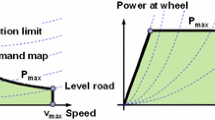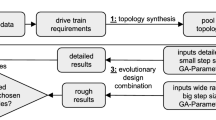Abstract
Over the last few years, the automotive industry has been moving toward pollutant-free and economically sustainable alternatives due to increased regulations concerning CO2 emissions. The hybrid and pure electric transmissions have been proposed to not violate these constraints.
The use of new electrical and electronic components has led to new challenges in terms of space optimisation. Various synthesis tools have been developed over the years for electric and hybrid transmissions to analyse these new solutions thoroughly and effectively.
At times, the components are calculated through databases and are standardised and not developed for the specific case which causes an oversize of the parts.
The size of the Electro-Magnetic Interference Suppression Filter (EMI filter) can contribute up to 30% of the inverter’s total size and weight. Therefore, designing a filter with high-power density and small volume is fundamental. The purpose of this paper is to create an algorithm capable of evaluating the physical and geometric characteristics of an EMI filter, varying the conditions of use. Furthermore, the algorithm can consider geometric constraints.
Zusammenfassung
Aufgrund der immer strenger werdenden gesetzlichen Rahmenbedingungen bezüglich CO2-Emissionen befindet sich die Automobilindustrie im Wandel. Um diese gesetzlichen Vorgaben zu erfüllen, werden die Fahrzeuge zunehmend elektrifiziert.
Der damit einhergehende Anteil elektrischer und elektronischer Komponenten im Antrieb führt zu neuen Herausforderungen im Bereich der geometrischen Integration. Um den sich hierbei ergebenden Lösungsraum effizient und vollständig bewerten zu können, wurden in den letzten Jahren verschiedene Algorithmen zur Auslegung dieser Komponenten entwickelt.
Diese Auslegungsroutinen bedienen sich standardisierter Datenbanken, um die Komponenten zu dimensionieren, was dazu führt, dass diese überdimensioniert sind.
Die Größe des Filters zur Unterdrückung elektromagnetischer Interferenz (EMI) kann bis zu 30% des Umrichtergewichts und –volumen ausmachen. Aus diesem Grund ist eine Leistungsdichte und kompakte Auslegung des Filters unabdingbar. In diesem Paper wird ein Algorithmus vorgeschlagen, der es ermöglicht, die physikalischen und geometrischen Eigenschaften eines EMI-Filters unter Berücksichtigung frei wählbarer Anforderungen zu bewerten. Zusätzlich können geometrische Randbedingungen berücksichtigt werden.







Similar content being viewed by others
References
Grobler, I., Gitau, M. N. (2017): Modelling and measurement of high-frequency conducted electromagnetic interference in DC–DC converters. IET Sci. Meas. Technol., 11, 495–503.
Boillat, D. O., Krismer, F., Kolar, J. W., Filter, E. M. I. (2017): Volume minimization of a three-phase, three-level T-type PWM converter system. IEEE Trans. Power Electron., 32(4), 2473–2480.
Wang, F., Shen, W., Boroyevich, D., Ragon, S., Stefanovic, V., Arpilliere, M. (2006): Design optimization of industrial motor drive power stage using genetic algorithms. In Proceedings of the IEEE industry applications conference, 8–12 October 2006. Tampa, FL, USA (pp. 2581–2586).
Raggl, K., Nussbaumer, T., Kolar, J. W. (2010): Guideline for a simplified differential-mode EMI filter design. IEEE Trans. Ind. Electron., 57, 1031–1040.
Filomeno, G., Krüger, B., Tenberge, P., Dennin, D. (2020): Automatization of pin fin heat sink design with geometric and fluid constraints. Int. J. Mech. Eng. Robot. Res., 9(5), 652–657. https://doi.org/10.18178/ijmerr.9.5.652-657.
Filomeno, G., Krüger, B., Tenberge, P., Dennin, D. (2020): Rapid electric motor sizing estimation for automotive application with statistical approach using catalog values. Int. J. Mech. Eng. Robot. Res., 9(11), 1457–1462. https://doi.org/10.18178/ijmerr.9.11.1457-1462.
Manushyn, I. (2019): In Design and optimization of EMI filters for power electronics systems, Darmstadt: Technische Universität Darmstadt.
Giglia, G., Ala, G., Di Piazza, M. C., Giaconia Luna Massimiliano, G. C., Vitale, G., Zanchetta, P. (2018): Automatic EMI filter design for power electronic converters oriented to high power density. Electronics, 7, 9. https://doi.org/10.3390/electronics7010009.
Foong, S. K., Lim, C. H. (2002): On the capacitance of a rolled capacitor. Phys. Educ., 37(5), 429.
Montanari, D., Saarien, K., Scagliarini, F., Zeidler, D., Niskala, M., Nender, C. (2009): Film capacitors for automotive and industrial applications. In CARTS USA 2009, 29th symposium for passive electronics, Jacksonville, FL, USA.
Petrovic, M. M. V., Bobic, J. D., Stojanovic, B. D. (2008): History and challenges of barium titanate: part II. Sci. Sinter., 40(3), 235–244. https://doi.org/10.2298/SOS0803235V.
Ceramic dielectric capacitors classes I, II, III and IV – part I: characteristics and requirements, EIA Standard, November 2002.
Kishi, H., Mizuno, Y., Chazono, H. (2003): Base-metal electrode-multilayer ceramic capacitors: past, present and future perspectives. Jpn. J. Appl. Phys., 42, 1–15.
Keimasi, M. (2007): Flex cracking and temperature-humidity-bias effects on reliability of multilayer ceramic capacitors, Center for Advanced Life Cycle Engineering, University of Maryland, USA.
Mikkenie, R. (2011): Materials development for commercial multilayer ceramic capacitor. Ph.D. Thesis, University of Twente.
Cava, R. J. (2001): Dielectric materials for applications in microwave communications. J. Mater. Chem., 11(1), 54–62.
Choi, J. H., Kim, J., Lee, B. T., Kim, Y. M., Moon, J. H. (2000): Microwave dielectric properties of Ba-Nd-Ti-O system doped with metal oxides. Mater. Lett., 44(1), 29–34.
Fiedziuszko, S. J., Hunter, I. C., Itoh, T., Kobayashi, Y., Nishikawa, T., Stitzer, S. N., Wakino, K. (2002): Dielectric materials, devices, and circuits. IEEE Trans. Microw. Theory Tech., 50(3), 706–720.
Wakino, K., Nishikawa, T., Ishikawa, Y., Tamura, H. (1990): Dielectric resonator materials and their applications for mobile communication-systems. Br. Ceram., Trans. J., 89(2), 39–43.
Kell, R. C., Greenham, A. C., Olds, G. C. E. (1973): High permititivity temperature-stable ceramic dielectrics with low microwave loss. J. Am. Ceram. Soc., 56(7), 352–354.
Suvorov, D., Valent, M., Kolar, D. (1997): The role of dopants in tailoring the microwave properties of Ba6-xR8+2/3xTi18O54 R = (La-Gd) ceramics. J. Mater. Sci., 32(24), 6483–6488.
Kumar, M., Agarwal, V. (2006): Power line filter design for conducted electromagnetic interference using time-domain measurements. IEEE Trans. Electromagn. Compat., 48, 178–186.
Yoann, M. Y. (2008): High-Density Discrete Passive EMI Filter Design for Dc-Fed Motor Drives, Master Thesis, Dept. of Elect. Eng., Virginia Polytechnic Institute and State University.
SAE AS 1831:1997 (R2010) Characteristics and Utilization of Electrical Power, 270 V DC, Aircraft.
Requirements for the control of electromagnetic interference characteristics of subsystem and equipment, Military Standard 461F, Dec. 2007.
“SAE AS 1831:1997 (R2010) Characteristics and Utilization of Electrical Power, 270 V DC”.
Author information
Authors and Affiliations
Corresponding author
Additional information
Publisher’s Note
Springer Nature remains neutral with regard to jurisdictional claims in published maps and institutional affiliations.
Rights and permissions
About this article
Cite this article
Filomeno, G., Krüger, B., Tenberge, P. et al. Automatic EMI filter design for three-phase PWM inverter used in automotive transmission. Elektrotech. Inftech. 138, 110–116 (2021). https://doi.org/10.1007/s00502-021-00870-9
Received:
Accepted:
Published:
Issue Date:
DOI: https://doi.org/10.1007/s00502-021-00870-9




